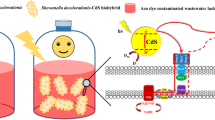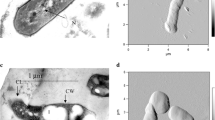Abstract
Biodegradation of triphenylmethane dyes by microorganisms is hampered by the transport barrier imposed by cell membranes. On the other hand, cell-free systems using enzyme-based biodegradation strategy are costly. Therefore, an efficient and inexpensive approach circumventing these problems is highly desirable. Here, we constructed a self-sufficient system for synthetic dye removal by coupling of spore surface-displayed triphenylmethane reductase (TMR) and glucose 1-dehydrogenase (GDH) for the first time. Display of both TMR and GDH significantly enhanced their stability under conditions of extreme pH and temperature. These engineered spores also exhibited more robust long-term stability than their purified counterparts. Furthermore, we observed that a high ratio of spore-displayed GDH is necessary for high dye degradation efficiency. These results indicate that this continuous dye removal system with cofactor regeneration offers a promising solution for dye biodegradation applications.




Similar content being viewed by others
References
Bae W, Mehra RK, Mulchandani A, Chen W (2001) Genetic engineering of Escherichia coli for enhanced uptake and bioaccumulation of mercury. Appl Environ Microbiol 67:5335–5338
Chen W, Georgiou G (2002) Cell-surface display of heterologous proteins: from high-throughput screening to environmental applications. Biotechnol Bioeng 79:496–503
Ding H, Du Y, Liu D, Li Z, Chen X, Zhao Y (2011) Cloning and expression in E. coli of an organic solvent-tolerant and alkali-resistant glucose 1-dehydrogenase from Lysinibacillus sphaericus G10. Bioresour Technol 102:1528–1536
Ding H, Gao F, Liu D, Li Z, Xu X, Wu M, Zhao Y (2013) Significant improvement of thermal stability of glucose 1-dehydrogenase by introducing disulfide bonds at the tetramer interface. Enzym Microb Technol 53:365–372
Doerner A, Rhiel L, Zielonka S, Kolmar H (2014) Therapeutic antibody engineering by high efficiency cell screening. FEBS Lett 588:278–287
Driks A (2002) Maximum shields: the assembly and function of the bacterial spore coat. Trends Microbiol 10:251–254
Fishilevich S, Amir L, Fridman Y, Aharoni A, Alfonta L (2009) Surface display of redox enzymes in microbial fuel cells. J Am Chem Soc 131:12052–12053
Gao F, Ding H, Feng Z, Liu D, Zhao Y (2014) Functional display of triphenylmethane reductase for dye removal on the surface of Escherichia coli using N-terminal domain of ice nucleation protein. Bioresour Technol 169:181–187
Gao F, Ding H, Shao L, Xu X, Zhao Y (2015) Molecular characterization of a novel thermal stable reductase capable of decoloration of both azo and triphenylmethane dyes. Appl Microbiol Biotechnol 99:255–267
Harwood CR, Cutting SM (1990) Molecular biological methods for Bacillus. Wiley, New York
Isticato R et al. (2004) Assembly of multiple CotC forms into the Bacillus subtilis spore coat. J Bacteriol 186:1129–1135
Isticato R, Ricca E (2014) Spore surface display. Microbiology spectrum 2:1–15
Jang M, Lee Y, Kim C, Lee J, Kang D, Kim S, Lee Y (2005) Triphenylmethane reductase from Citrobacter sp. strain KCTC 18061P: purification, characterization, gene cloning, and overexpression of a functional protein in Escherichia coli. Appl Environ Microbiol 71:7955–7960
Li G, Tang Q, Chen H, Yao Q, Ning D, Chen K (2011) Display of Bombyx mori nucleopolyhedrovirus GP64 on the Bacillus subtilis spore coat. Curr Microbiol 62:1368–1373
Liang B, Lang Q, Tang X, Liu A (2013) Simultaneously improving stability and specificity of cell surface displayed glucose dehydrogenase mutants to construct whole-cell biocatalyst for glucose biosensor application. Bioresour Technol 147:492–498
Liu W, Wang P (2007) Cofactor regeneration for sustainable enzymatic biosynthesis. Biotechnol Adv 25:369–384
Nicholson W, Setlow P (1990) Sporulation, germination and outgrowth in molecular biological methods for Bacillus. In: Harwood CR, Cutting SM (eds) . Wiley, Chichester, pp. 391–450
Nicholson W, Munakata N, Horneck G, Melosh H, Setlow P (2000) Resistance of Bacillus endospores to extreme terrestrial and extraterrestrial environments. Microbiol Mol Biol Rev 64:548–572
Schüürmann J, Quehl P, Festel G, Jose J (2014) Bacterial whole-cell biocatalysts by surface display of enzymes: toward industrial application. Appl Microbiol Biotechnol 98:8031–8046
Srivastava S, Sinha R, Roy D (2004) Toxicological effects of malachite green. Aquat Toxicol 66:319–329
Xu X, Gao C, Zhang X, Che B, Ma C, Qiu J, Tao F, Xu P (2011) Production of N-acetyl-D-neuraminic acid by use of an efficient spore surface display system. Appl Environ Microbiol 77:3197–3201
Zeng J, Eckenrode H, Dounce S, Dai H (2013) Time-resolved molecular transport across living cell membranes. Biophys J 104:139–145
Acknowledgments
This study was supported by the National Natural Science Foundation of China (31470191; 41271335; 31200599) and the Major State Basic Research Development Program of China (973 Program) (2015CB150502).
Author information
Authors and Affiliations
Corresponding author
Ethics declarations
Conflict of interest
The authors declare that they have no conflict of interest.
Additional information
Responsible editor: Gerald Thouand
Fen Gao and Haitao Ding contributed equally to this work.
Rights and permissions
About this article
Cite this article
Gao, F., Ding, H., Xu, X. et al. A self-sufficient system for removal of synthetic dye by coupling of spore-displayed triphenylmethane reductase and glucose 1-dehydrogenase. Environ Sci Pollut Res 23, 21319–21326 (2016). https://doi.org/10.1007/s11356-016-7330-9
Received:
Accepted:
Published:
Issue Date:
DOI: https://doi.org/10.1007/s11356-016-7330-9




